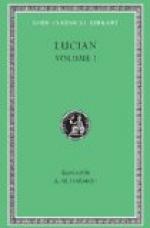Below Point Hausbrough, named in honor of Peter M. Hausbrough, who was drowned during the first exploring trip, the canon widens rapidly. The marble benches are replaced by strata of limestone and between the river and the rocks green fields and groves of trees become common. The view from the river, looking across this verdure, with sandstone rocks for the immediate background, and snow-capped mountains in the distance, is extraordinary in its magnificence and combinations. Between the grand junction of the Little Colorado with the main canon and the Granite Gorge, there is about eight hundred miles of a very different section. Evidences of volcanic action abound. Rocks and boulders seem to have been blown out of position and mixed up all in a heap. The rocks are largely charged with mineral, and, as a result, almost every known color is represented, in the most remarkable purity. The river runs through a wide valley, with the top walls several miles apart.
The Granite Gorge itself is entirely different. Here the great walls of granite start from the water’s edge. The first few feet are usually vertical. Then, for a thousand feet or more, the rise is at an angle of about 45 degrees, while occasionally masses of rock stand out prominently and overhang the river. Above the granite comes a mass of dark colored sandstone, with a vertical front. In many places it is perfectly black, the color being intensified by the brightness of the red below. If an artist were to paint a cliff deep red, with a jet black border along the top, Old World critics would be apt to declare him insane. Yet this is really the coloring of this section of the most wonderful canon in the entire world.
Although the canon at this point varies in width at the top from six to twelve miles, the river really runs through a narrow gorge, and partakes very much of the nature of a long rapid or cataract. For ten miles the fall averages twenty-one feet per mile, sufficient to make the current very dangerous even at low water, and something terrible after heavy rains or much snow melting. In one place the fall is eighty feet in about five hundred yards, and here, of course, navigation is practically out of the question. The explorers, to whom we have referred, were compelled to proceed with great deliberation at this point. Occasionally they ran the rapids, but very often they were compelled to lower their boats by means of lines, and even to lift them over exceptionally dangerous rocks.




